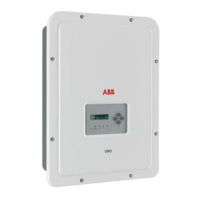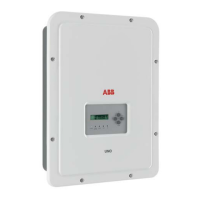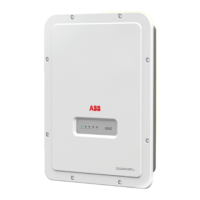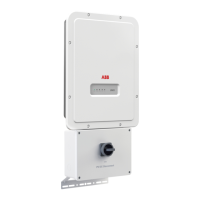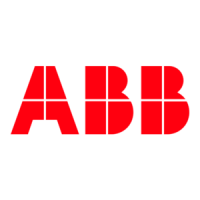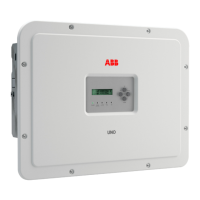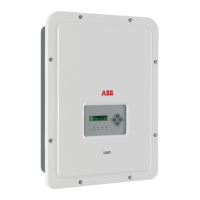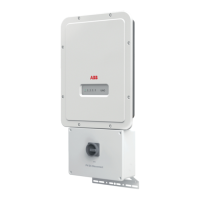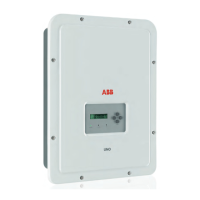Do you have a question about the ABB UNO-DM-2.0-TL-PLUS-Q and is the answer not in the manual?
Key safety guidelines for inverter installation and operation.
Explains various danger and hazard zone indicators used in the manual.
Covers general, environmental, and electrical safety during installation.
General precautions for safe installation and maintenance practices.
Risks associated with environmental conditions during installation.
Critical safety instructions regarding electrical hazards and thermal risks.
Comprehensive technical specifications for various inverter models.
Explains how the inverter limits power under specific conditions.
Details how ambient temperature affects power output.
Shows how input voltage variations impact power output.
Describes the inverter's built-in safety mechanisms.
Explains the anti-islanding disconnection system for grid safety.
Details the ground fault detection and disconnection mechanism.
General instructions and requirements for correct inverter installation.
Step-by-step instructions for securely mounting the inverter on a wall.
Pre-connection checks for the PV generator.
Explains the integrated differential protection against ground faults.
Step-by-step guide for connecting the PV generator to the inverter's DC inputs.
Detailed installation steps for various quick-fit connector types.
Instructions for connecting the inverter to the AC grid.
Specifies requirements for AC disconnect switches for protection.
Step-by-step guide for commissioning the inverter via its web interface.
Connects the inverter to a local Wi-Fi network for initial setup.
Accessing the inverter's web user interface for configuration.
Setting up administrator and user accounts for interface access.
Connecting the inverter to the home wireless network (Station Mode).
Setting grid standards, input modes, and meter configurations.
Explains the meaning of different LED combinations indicating inverter status.
Overview of the inverter's internal webserver functionality.
Configuration settings for AC, DC, and ground fault parameters.
Manages power flow for self-consumption or grid feed-in.
Procedure for safely de-energizing the inverter for maintenance.
Required skills and qualifications for personnel performing maintenance.
Specifies required Personal Protective Equipment (PPE) for interventions.
Lists necessary tools and safety equipment for maintenance.
Detailed step-by-step procedure for de-energizing and accessing the inverter.
Procedures for operating external AC disconnect switches.
Procedures for operating external DC disconnect switches.
Procedure for operating the internal DC disconnect switch.
Recommended routine maintenance operations for long-term performance.
Guidance for identifying and resolving common inverter issues.
Troubleshooting steps for web interface and wireless connectivity problems.
Lists and explains inverter alarm codes and their solutions.
Key safety guidelines for inverter installation and operation.
Explains various danger and hazard zone indicators used in the manual.
Covers general, environmental, and electrical safety during installation.
General precautions for safe installation and maintenance practices.
Risks associated with environmental conditions during installation.
Critical safety instructions regarding electrical hazards and thermal risks.
Comprehensive technical specifications for various inverter models.
Explains how the inverter limits power under specific conditions.
Details how ambient temperature affects power output.
Shows how input voltage variations impact power output.
Describes the inverter's built-in safety mechanisms.
Explains the anti-islanding disconnection system for grid safety.
Details the ground fault detection and disconnection mechanism.
General instructions and requirements for correct inverter installation.
Step-by-step instructions for securely mounting the inverter on a wall.
Pre-connection checks for the PV generator.
Explains the integrated differential protection against ground faults.
Step-by-step guide for connecting the PV generator to the inverter's DC inputs.
Detailed installation steps for various quick-fit connector types.
Instructions for connecting the inverter to the AC grid.
Specifies requirements for AC disconnect switches for protection.
Step-by-step guide for commissioning the inverter via its web interface.
Connects the inverter to a local Wi-Fi network for initial setup.
Accessing the inverter's web user interface for configuration.
Setting up administrator and user accounts for interface access.
Connecting the inverter to the home wireless network (Station Mode).
Setting grid standards, input modes, and meter configurations.
Explains the meaning of different LED combinations indicating inverter status.
Overview of the inverter's internal webserver functionality.
Configuration settings for AC, DC, and ground fault parameters.
Manages power flow for self-consumption or grid feed-in.
Procedure for safely de-energizing the inverter for maintenance.
Required skills and qualifications for personnel performing maintenance.
Specifies required Personal Protective Equipment (PPE) for interventions.
Lists necessary tools and safety equipment for maintenance.
Detailed step-by-step procedure for de-energizing and accessing the inverter.
Procedures for operating external AC disconnect switches.
Procedures for operating external DC disconnect switches.
Procedure for operating the internal DC disconnect switch.
Recommended routine maintenance operations for long-term performance.
Guidance for identifying and resolving common inverter issues.
Troubleshooting steps for web interface and wireless connectivity problems.
Lists and explains inverter alarm codes and their solutions.
| Type | String Inverter |
|---|---|
| Number of MPPT | 2 |
| Cooling | Natural convection |
| Protection Class | IP65 |
| Nominal AC Power | 2000 W |
| Nominal AC Voltage | 230 V |
| Topology | Transformerless |
| DC Connection | MC4 |
| Frequency Range | 50 / 60 Hz |
| Operating Temperature Range | -25 °C to +60 °C |
| Max. AC Power | 2200 W |
| AC Connection | Plug type |
